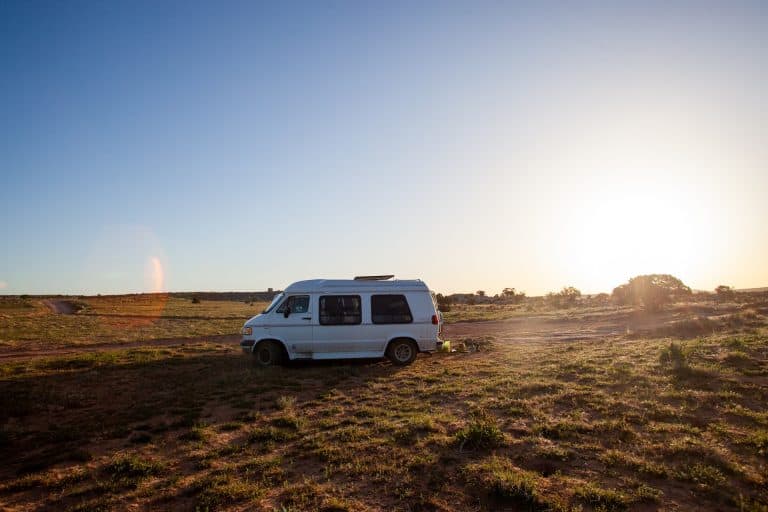How To Plan a Road Trip In 7 Easy Steps
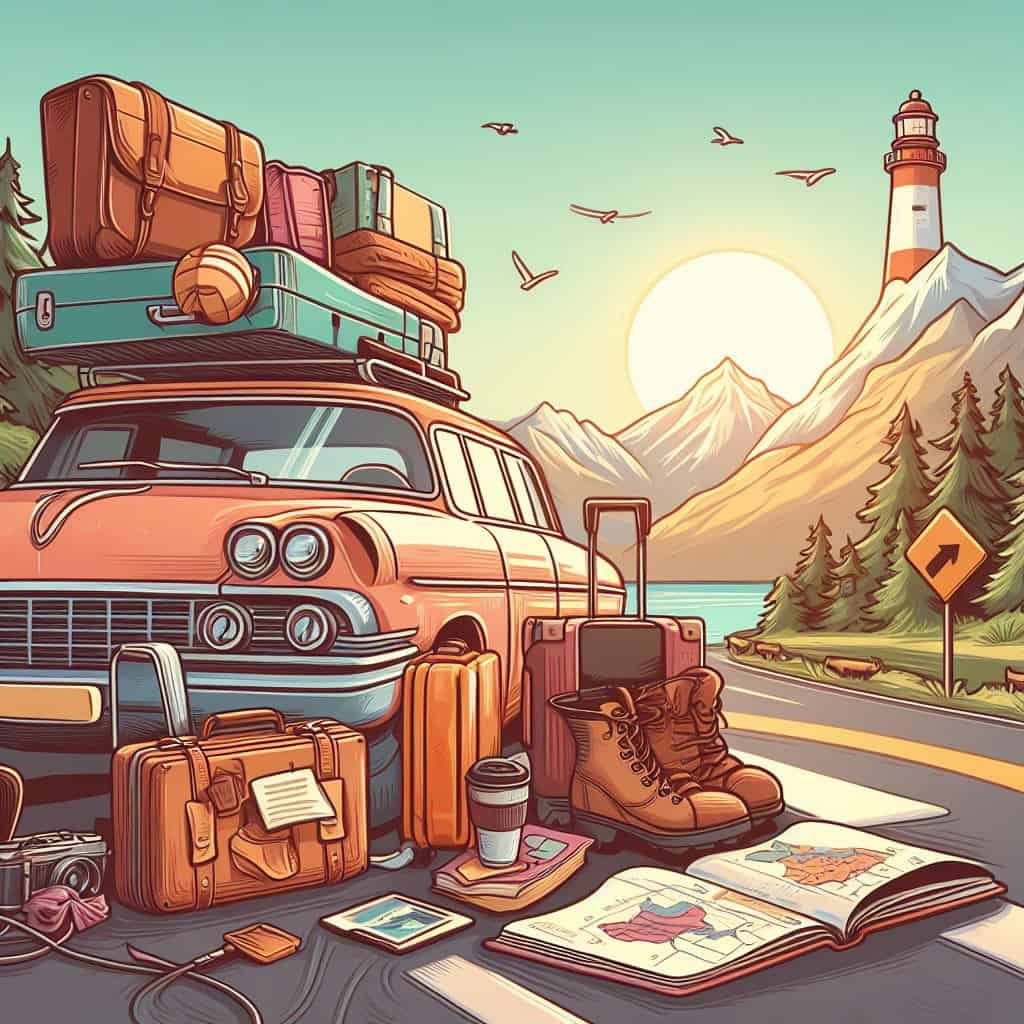
Ready to hit the road but not sure where to start? Want to learn how to plan a road trip in a few simple steps?
From choosing unforgettable destinations to prepping your vehicle, we’ve broken down seven important steps to make your road trip planning less of a hassle.
Whether you are a seasoned traveler or a first-time road tripper, this guide will ensure you’re well-equipped for the journey ahead.
TL;DR:
- Set Your Budget and Timeline: Establish your travel budget and timeline, considering costs for fuel, accommodation, and food. Balance your finances with available time for a smooth trip.
- Choose Your Destinations: Pick your main and secondary stops, mixing famous sites with off-the-beaten-path locations. Use tools for route planning to enhance your experience.
- Plan Your Route: Map out your route, including main roads and scenic detours. Balance structured travel with spontaneity to add variety.
- Arrange Accommodations: Book hotels, campsites, or unique stays like B&Bs or cabins in advance. Match your accommodation choice with the nature of your trip.
- Prepare Your Vehicle: Conduct essential vehicle maintenance checks and pack an emergency kit. Ensure your entire vehicle is safe and reliable for the journey.
- Pack Smartly: Focus on essentials for comfort and convenience. Prepare and pack for various weather conditions and unexpected situations.
- Plan for Entertainment and Activities: Create a road trip playlist and plan activities for each location. Include a variety of experiences to make your trip more memorable.
Conclusion: Road trip planning involves collaboration, using modern tools, and foresight for a memorable and successful journey.
What Are the Steps For How To Plan a Road Trip?
There are several things you will want to keep in mind when planning for your next road trip.
Are you renting a car or driving your own? Will you be staying in luxurious hotels or roughing it at campgrounds? Who knows, you might just plan on sleeping in your car! Whatever your plan, it should be thought out carefully to avoid any disasters.
Here’s a list of 7 easy steps for planning your next road trip.
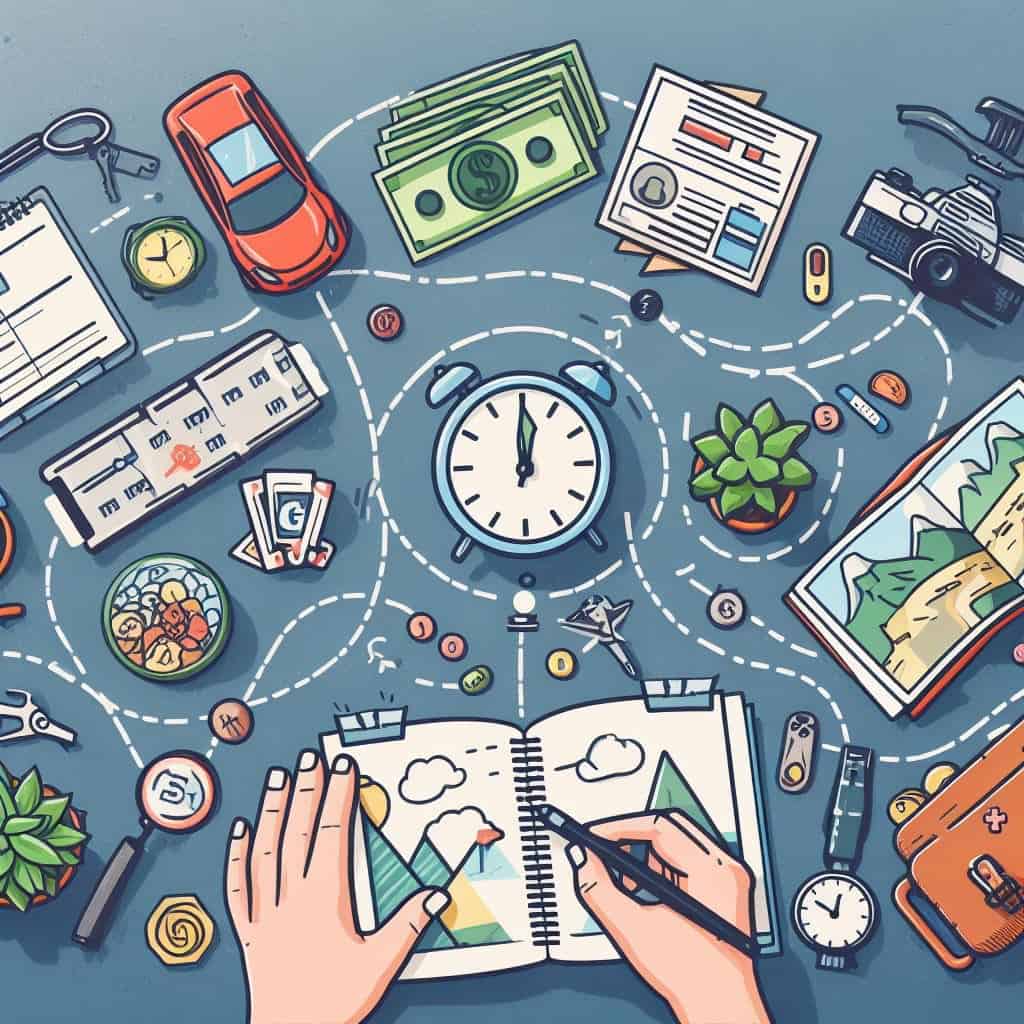
1. Set Your Budget and Timeline
Before you start flipping through your atlas or marking spots on your digital app, it’s crucial to establish two key aspects of your trip: your budget and your timeline.
Your budget is like the backbone of your itinerary; it determines how far you can travel, where you can stay, and what activities you can enjoy.
Meanwhile, your timeline is the framework that shapes your travels, from the mileage you cover each day to the duration of your stops. Setting a realistic budget and a feasible timeline upfront will not only ensure a smoother journey but also help you avoid unexpected expenses and time constraints.
Aligning your financial limits with the time you have available allows you to create a balanced and achievable road trip plan. This way, you can enjoy your trip without the stress of overspending or rushing through your itinerary.
Calculating Costs: Fuel, Accommodation, and Food
When you start planning your road trip, a crucial step is calculating the costs of fuel, accommodation, and food. These are the pillars of your road trip budget.
Begin by estimating the fuel costs based on your vehicle’s mileage and the distance you’ll be traveling. (TIP) Remember to factor in extra time and mileage for any scenic detours or stops you want to include.
Next, consider your accommodations: are you camping, boondocking, staying in hotels, or crashing with friends or family? Prices can vary greatly, so choose options that work with your budget.
Lastly, plan for your food expenses. Will you be dining out, cooking at campsites, or maybe a little bit of both? Getting the big picture of your necessary finances and budget will keep you from unfortunate and unexpected surprises.
Deciding on the Length of Your Trip
Determining how long your road trip will last is as essential as picking your final destination. The length of your trip depends on several factors, including the distance to your destination, the number of stops you plan to make, and how long you wish to spend at each location.
When mapping out your driving directions, consider the distance and the time needed for each segment of your journey. Allow for periods to stretch your legs, explore, and rest.
A good rule of thumb is not to overpack your days; instead, leave room for spontaneous adventures and relaxation. If my budget allows it, I will sometimes under-pack to allow room for any unique souvenirs or clothes that I may buy along the way.
The duration of your trip should reflect a balance between reaching your destination and enjoying the journey itself. A well-paced trip means you can soak in the experiences without feeling rushed, making your road trip a memorable and enjoyable time.

2. Choose Your Destination(s)
Selecting your destination is the moment when your road trip starts to take shape. It’s not just about the endpoint, but also the planned stops along the way that enrich your experience.
To plan the best route, consider using a combination of a website and an app that specializes in road trip planning. These tools can offer valuable insights into the most scenic paths, interesting landmarks, and must-visit places that align with your interests.
Think about what you want to experience: Are you interested in taking in natural landscapes, bustling city scenes, or quiet small towns?
Your destinations should reflect the kind of adventure you’re seeking. By choosing your main and secondary stops thoughtfully, you turn a simple drive into a possible discovery of new places that you never would have thought existed.
Picking Primary and Secondary Stops
When mapping out your itinerary, and choosing your main and secondary stops thoughtfully, you can turn a simple drive into a possible discovery of new places that you never would have thought existed.
Utilizing tools like Google Maps can be incredibly helpful in visualizing your route and determining logical and exciting stops.
For your primary stops, think about major destinations you absolutely HAVE to visit. These could be a famous city, a renowned national park, or a hidden gem that’s always been on your bucket list.
Then, consider secondary stops, which oftentimes can be the most memorable.
These could be small towns, lesser-known parks, or unique attractions that lie along your route. Balancing well-known places with off-the-beaten-path experiences can make your road trip truly unique and memorable.
Take your time to research and select these stops, ensuring they add variety and some excitement to your road trip journey.
Exploring Off-the-Beaten-Path Options
When embarking on a long road trip, the allure of the unknown and the less traveled paths can add an element of surprise and excitement to your experience.
It’s worth taking the time to explore off-the-beaten-path options that might not be on every tourist’s list. Make a note of unique landscapes, quirky places, or local eateries that offer a taste of regional flavor.
These hidden spots often provide some of the most memorable experiences and stories. When planning, consider these less conventional spots and think about how they can fit into your overall route.
While it’s great to have a well-structured plan, allowing for some spontaneity to explore these lesser-known locations can enrich your road trip significantly.
You might want to consider a flexible day in your itinerary specifically dedicated to unplanned adventures. This can take some of the pressure off of staying on a tight schedule and just letting the day take shape.

3. Plan Your Route
Planning your next road trip involves more than just picking destinations; it’s about creating the journey between them. When you plan ahead, you create a balance between the planned and unplanned, ensuring you have a structured route while leaving room for spontaneity.
Mapping out your route beforehand gives you a clear picture of your trip’s direction – from the long stretches of highway to the winding back roads. It’s about finding that sweet spot where structure meets flexibility.
With a well-thought-out route, you’ll know your key stopping points but also have the freedom to explore hidden nooks and unexpected detours that add richness to your road trip experience.
Let’s dive into how to craft a route that brings your road trip to life, blending both planned and spontaneous travel.
Mapping Out the Main Route
When you’re already planning your road trip, one of the first steps is to map out your main route. This is where travel guides and online resources become incredibly valuable.
If you are lacking inspiration or are unsure about which routes to take, these guides can offer suggestions for the most scenic and enjoyable places.
They can also highlight key sights along the way, ensuring you don’t miss out on any must-see destinations. Consider the overall distance, the time it will take to travel, and especially how much of your day you want to spend driving.
It’s important to balance reaching your destinations and enjoying the journey itself. While the main route serves as your road trip’s structure, it should also allow flexibility for impromptu exploring and leisurely stops, making your road trip as enjoyable as possible.
Including Scenic Detours and Rest Stops
In the process of planning your route, don’t forget to include scenic detours and rest stops. These are the elements that can transform a good road trip into a great one.
Using a trip planner, identify interesting detours that might not add too many miles to your journey but offer a unique experience. Perhaps there’s a breathtaking lookout point, an awesome campground, or a historic site just out of the way.
These detours can provide a refreshing break from driving and a chance to stretch your legs in beautiful surroundings.
Also, consider the placement of rest stops. These aren’t just necessities for refueling and restroom breaks; they can also be opportunities to discover local attractions, enjoy a picnic, or simply relax and take in the view.
Many state welcome centers are combined with rest areas and can offer valuable information about the local area.
Integrating these elements into your road trip ensures that the journey between your main destinations is just as memorable as the destinations themselves.

4. Arrange Accommodations
One of the most critical things I consider when planning a road trip, especially a cross-country road trip, is where I’ll rest my head at night.
Accommodation choices can greatly influence your overall experience, so it’s important to plan accordingly.
Whether you’re seeking luxury hotels, intimate bed-and-breakfasts, or scenic campgrounds, each option offers different perspectives to your journey.
Think about the type of experience you want to have and the level of comfort you desire after a day of exploring. Your choices should align not only with your budget but also with the nature of your trip.
For example, a romantic getaway might call for quaint inns, while a rugged camping adventure might have you pitching a tent under the stars.
Planning your accommodations in advance ensures that you have a secure and comfortable place to recharge, ready for the next day’s adventures.
Let’s explore the various accommodation options to find the perfect fit for your road trip.
Booking Hotels or Campsites in Advance
Booking your hotels or campsites in advance is my main strategic move, especially in the areas where I’d like to stop and spend at least a couple of days exploring.
Plus, after hours of driving, the feeling of knowing that you have a confirmed place to stay can provide peace of mind and comfort.
When selecting hotels, consider their location in relation to your route and the attractions you want to visit. For campsites, research the amenities and proximity to natural landmarks or hiking trails.
By securing your accommodations beforehand, you can ensure that you’re staying in the best spots that align with your itinerary and preferences.
This foresight also often gives you access to better rates and choice locations that might be quickly booked by spontaneous travelers.
Whether you’re looking for a luxurious hotel room to unwind in or a scenic campsite to connect with nature, planning ahead means you can make the most of your stops and your pocketbook!
Considering Unique Stay Options like B&Bs or Cabins
When you’re traveling, especially as a group of road trippers, exploring unique stay options like bed-and-breakfasts (B&Bs) or cabins can significantly enhance your experience.
These accommodations often provide a more personalized and intimate setting, perfect for when you want to spend some time away from the busyness of typical hotels.
B&Bs, with their homey feel and local charm, offer a chance to immerse yourself in the area you’re visiting, often accompanied by top-notch homemade breakfasts and useful tips from your hosts.
Cabins, on the other hand, can provide a rustic and serene escape, especially appealing if you’re traveling through scenic countryside or near national parks.
These can be ideal if you like to camp in the woods, but want something other than tent camping.
Staying in these unique accommodations allows for a deeper connection with the places you visit, turning each stay into an experience in itself.
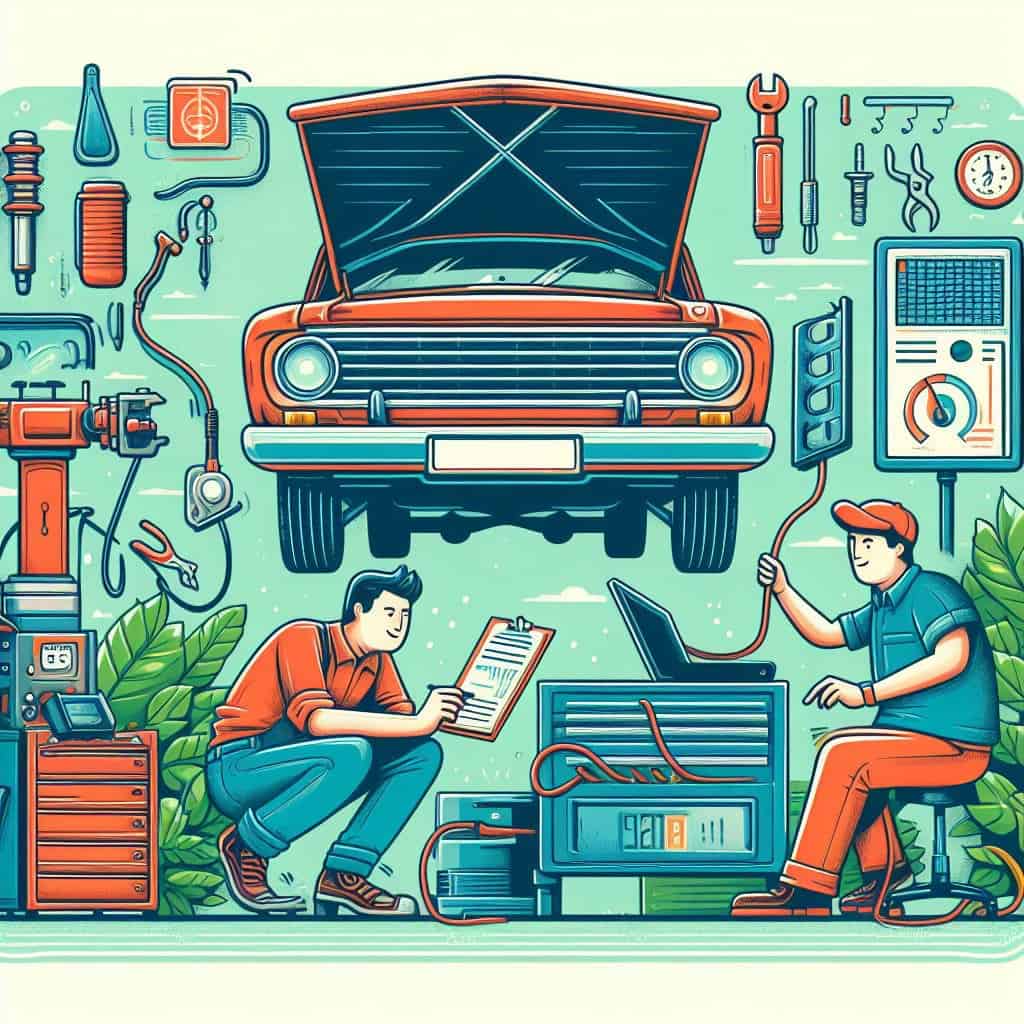
5. Prepare Your Vehicle
When you’re traveling by car, RV, or embarking on a campervan road trip, ensuring your vehicle is in top condition is vital.
Your vehicle is not just a means of transportation; it’s your companion on this journey, your traveling home on wheels and the heart of your road trip experience.
Proper preparation can be the difference between a smooth adventure and an unfortunate breakdown.
This step is about more than just a quick check-up; it involves a thorough review of all the key components of your vehicle to ensure safety, comfort, and reliability throughout your trip.
From the engine to the tires, every aspect of your vehicle needs to be road-ready.
Essential Vehicle Maintenance Checks
When you’re planning on driving long distances, conducting essential vehicle maintenance checks is crucial for a pain-free journey.
Before you set out, take your vehicle for a thorough inspection. This includes checking the engine oil, brake fluid, and coolant levels, as well as ensuring your tires are properly inflated and have sufficient and even tread.
Don’t forget to inspect your battery, lights, and brakes, as these are critical for safety on the road.
Additionally, familiarize yourself with your vehicle’s specific needs – does it require a certain type of fuel that might not be available at all gas stations?
By addressing the key maintenance aspects, you’ll be able to confidently handle long stretches of driving and reduce the risk of a breakdown.
Packing an Emergency Kit and Roadside Supplies
When taking a road trip, being prepared for the unexpected is a requirement. Packing road trip essentials, such as an emergency kit and roadside supplies is a key step in ensuring your safety from point A to point B.
Your emergency kit should include items such as a first aid kit, flashlight, extra batteries, a multipurpose tool, and a blanket.
Additionally, don’t forget to pack basic roadside supplies like a spare tire, jack, jumper cables, and a tire pressure gauge.
It’s also wise to include items for specific situations, such as extra water and snacks in case of an emergency where you might be stranded for a while away from services.
These supplies can be lifesavers in the event of a breakdown or other unforeseen circumstances.
Additionally, you may want to consider a membership plan with a roadside assistance company like AAA.
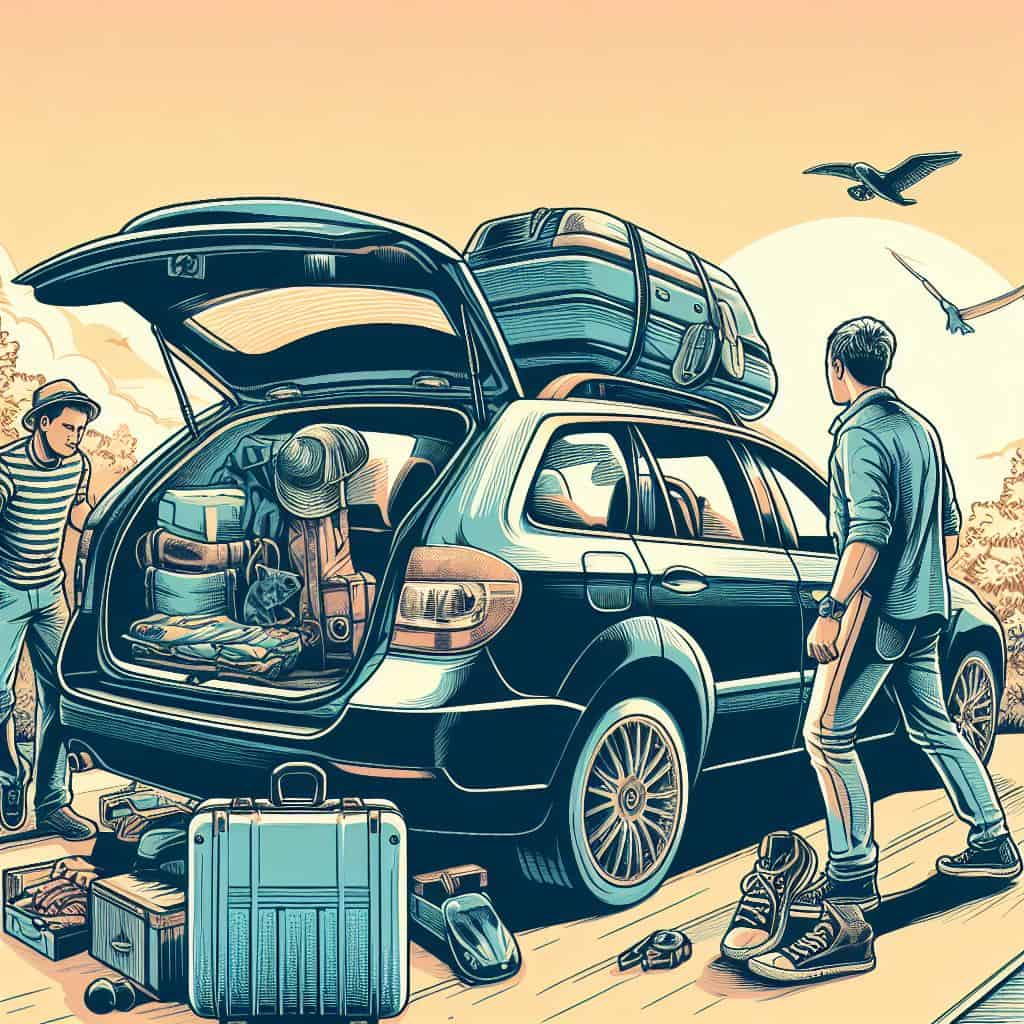
6. Pack Smartly
Packing for a road trip might sound straightforward, but it’s an art that can affect the bulk of your road trip experience.
Unlike other types of travel, road trips offer the unique challenge and advantage of having your vehicle work as both your transport and storage space.
The key is to pack efficiently. Bring along everything you need without cluttering your space.
From choosing the right luggage to deciding what essentials to bring, each choice plays a part in how enjoyable your journey will be.
Comfortable driving is about more than just the physical drive; it’s also about the ease and accessibility of your essentials.
This section will help you plan and organize your packing process, ensuring you have all your necessities within reach.
Essentials for Comfort and Convenience
When planning the perfect road trip, pay attention to the essentials. Whether you frequently go on road trips or you’re planning a road trip for the first time, these essentials can significantly enhance your experience.
Start with comfortable driving clothes and supportive footwear, as they can make long hours on the road more bearable.
Also, consider ergonomic support like back cushions or neck pillows, especially if you’re prone to stiffness.
For convenience, organize your items so that snacks, water bottles, chargers, and navigation tools are easily accessible.
It’s also wise to pack a good cooler for fresh snacks and drinks, a multi-port charger for all your devices, and an entertainment kit with music, audiobooks, or podcasts.
By balancing your packing list to include these comfort and convenience items, your road trip becomes a smooth and enjoyable process, letting you focus on the most important thing…the trip!
Packing for Weather and Unexpected Situations
While tacking on many miles along your road trip route, you’re likely to encounter various weather conditions and unexpected situations, particularly if you’re exploring different regions or kinds of roads.
To be well-prepared, pack clothing and gear suitable for a range of weather scenarios. Carry along an umbrella for potentially rainy days and some sunglasses and a hat for particularly sunny days.
Additionally, include layers like fleece or lightweight jackets that can be easily added or removed as temperatures change.
Temperature swings can be quite common at higher elevations, so even though it may be a hot summer day, the nighttime can be very different.
It’s also advisable to pack a small supply of non-perishable food, water, and basic first-aid items, as these can be invaluable in case of delays or detours.
Don’t forget to include items like extra batteries, a spare phone charger, and a physical map or printed directions as backups to digital devices.

7. Plan for Entertainment and Activities
While the scenic route of your road trip offers its own natural entertainment, planning additional activities and entertainment is key to making your experience a better one.
When you plan a road trip itinerary, it’s not just about the destinations; it’s about the journey and the experiences you gather along the way.
Think about how to engage with each location like a local. Seek out activities that allow you to surround yourself with the culture and natural beauty of the places you visit.
This could include everything from local music festivals and other outdoor adventures to historical tours and culinary experiences.
Including a variety of activities not only breaks up the driving time but also enriches your road trip, making each stop more memorable and exciting.
Creating the Perfect Road Trip Playlist
Music is an essential element when you plan a road trip, setting the mood as you hit the road. It can also act as an aid in staying awake during long drives.
A well-curated playlist can elevate your driving experience, turning long stretches into memorable moments of your trip.
To create the perfect playlist for your next trip, mix in a variety of genres that cater to different moods and scenery.
I like upbeat tunes for those high-energy mornings and mellow tracks for peaceful drives, and I always like to seek out some local music stations from the regions I pass through.
A personal road trip soundtrack will not only enhance your mood but will also become a sentimental reminder of your travels for years to come, bringing back all of the memories and locations as if you were just there.
Ideas for Roadside Attractions and Activities
An ultimate road trip is incomplete without exploring the unique roadside attractions and activities along your route.
Unless you are in a complete rush, these spontaneous stops often become the highlights of your journey.
While following your step-by-step guide, be open to the unexpected surprises found off the beaten path.
For instance, if your adventure takes you near the historic Route 66, seize the opportunity to experience the iconic diners, quirky museums, and vintage gas stations this historic road has to offer.
Researching your route beforehand can uncover hidden gems, like unusual landmarks, local festivals, or farmer’s markets.
Incorporate these into your trip not just as breaks from the road but as important parts of your road trip experience.

FAQ:
How Many Stops Should You Make On a Road Trip?
The number of stops you should make on a road trip varies depending on the total distance, your personal travel pace, and your interests. Aim for a stop every 2-3 hours to rest and explore.
What Is the Best Way To Plan a Road Trip With Multiple Stops?
The best way to plan a road trip with multiple stops is to first outline your main destinations and then identify interesting points along the way. Use road trip planning tools or apps to efficiently map your route, incorporating a mix of major attractions and lesser-known sites.
Can I Use Google Maps To Plan a Road Trip?
Yes, Google Maps is an effective tool for planning a road trip. It allows you to plot your route, add multiple stops, estimate travel times, and explore points of interest along the way.
How Much Should I Budget For a Road Trip Per Day?
The daily budget for a road trip varies based on factors like destination, travel style, and accommodation preferences. On average, account for expenses such as fuel, food, lodging, and entertainment. A general guideline is to budget between $50 to $150 per day.
Conclusion
Planning a road trip can be a daunting task, but it can also be an exciting process especially when you start to see your journey take shape.
It can also be a great way for everyone going on the road trip to come together and have fun discussing destinations, food stops, landmarks, and any other attractions that your group may want to take part in.
Thanks to our modern world of technology, finding apps and tools that can help you put together your perfect road trip is easier than ever.
With these tools along with a little foresight and proper planning, your road trip is sure to be a success!
